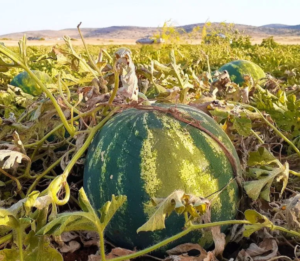
Watermelon field, Jordan Valley
Fareed Taamallah writes in Middle East Monitor, June 12, 2020:
For Palestinian Murad Sartawi, the watermelon is symbolic for its colours: red, green, black and white, resemble those of the flag of his country.
Palestinians in the occupied West Bank and in the northern Jordan Valley produced around 100,000 tonnes of watermelons each year in the 1980s, but this figure has steadily declined to 13,000 tonnes this year. Making up just a quarter of the annual domestic demand for watermelons, according to the Ministry of Agriculture.
The reduction of land available for cultivation represents the suffering of Palestinian farmers under Israeli occupation and the unjust distribution of water in the occupied territories.
Now, the Israeli occupation authority is planning to annex the Jordan Valley, leaving watermelon famers with an uncertain future and with no recourse to protection from the Palestinian government.
For decades, Israel has confiscated land owned by Palestinian farmers and allocated it to illegal settlers and deprived the remaining Palestinians of access to water, which is pumped without limits – and for free – to settlers.
READ: Nearly 1,600 trees vandalised by Israel settlers in the West Bank since start of 2020
Sleiman Sawafta is one of those small-scale Palestinian farmers who planted about 60 dunums (15 acres) of watermelon in the village of Bardala in the northern Jordan Valley, but didn’t harvest most of it, losing 150 tonnes of the crop.
‘All the watermelons ripened, but I couldn’t find the boxes to package them in because all the boxes were reserved for the Israeli watermelon which floods the local market’ he explains.
More …